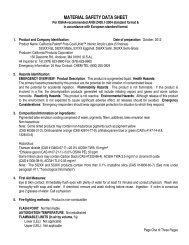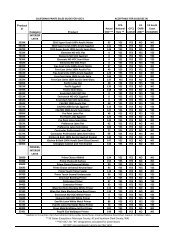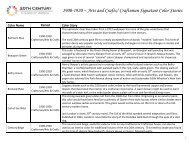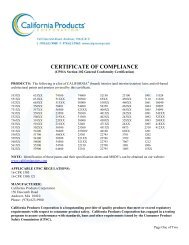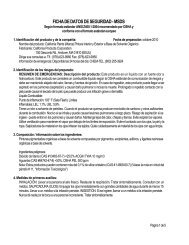MSDS - California Paints
MSDS - California Paints
MSDS - California Paints
You also want an ePaper? Increase the reach of your titles
YUMPU automatically turns print PDFs into web optimized ePapers that Google loves.
MATERIAL SAFETY DATA SHEETPer OSHA-recommended ANSI Z400.1-2004 standard format &in accordance with European standard format1. Product and Company Identifcation: Date of preparation: September, 2010Product Name: <strong>California</strong> ® <strong>Paints</strong> (Brand) Prime Choice Alkyd Primer/Sealer/Undercoater & Vapor Barrier No. 20200Producer: <strong>California</strong> Products Corporation150 Dascomb Rd., Andover, MA 01810 (U.S.A.)All Inquiries to: Tel: (978) 623-9980 Fax: (978) 623-9960Emergency Information: 24 Hour Contact: CHEM-TEL: (800) 255-3924 (Contract Number: MIS0001450)2. Hazards Identification:EMERGENCY OVERVIEW: Product Description: This product is a liquid with a strong hydrocarbon odor. Thisproduct is considered to be a combustible liquid per the OSHA hazard communication standard and should bekept away from heat, flame and sources of ignition. If swallowed, this product may get sucked into thelungs (aspirated) and cause lung damage or even death. Prolonged or repeated skin contact can cause drying ofthe skin, which may produce sever irritation or dermatitis.Combustible Liquid:Flash point: 103°F (Seta Flash).Flammable Limits: LEL: 1.1%, UEL: 5.9%It has a solvent petroleum odor. When burned the product produces carbon monoxide and other asphyxiates during combustion.Harmful if inhaled and may cause delayed lung injury. Aspiration hazard if swallowed – can enter lungs and cause damage. Keepaway from heat, sparks and flame. Avoid breathing vapor. Use ventilation to keep vapor below exposure limits. Avoid contactwith eyes, skin and clothing. Material splashed into the eyes will irritate tissues. Gently flush material from eyes with cleanwater.3. Composition/Information on Ingredients:Pigmented organic solvent-borne paints comprised of pigments, fillers, additives, and organic solvent-borneresinous binder.Hazardous ingredients:Titanium dioxide (CAS #13463-67-7)
6. Accidental release measures:STEPS TO BE TAKEN IN CASE MATERIAL IS RELEASED OR SPILLED: Remove all sources of ignition (flame, hot surfaces, andelectrical, static, or frictional sparks). Avoid breathing vapors. Use self-contained breathing equipment. Ventilate area. Containand remove with inert, absorbent material and non-sparking tools. Avoid contact. WASTE DISPOSAL METHOD: Disposal shouldbe done in accordance with Federal (40CFR Par 261), State and Local regulations. Before attempting clean-up, refer to hazardcaution information in other sections of the <strong>MSDS</strong>. Use licensed hazardous waste disposal concern.7. Handling and Storage:PRECAUTIONS TO BE TAKEN IN HANDLING AND STORING: Do not store or use near heat or open flame. Refer toOSHA 79CFR Part 1910.106 for specific storage requirements. Keep closure tight and container upright to preventleakage. Drums of this material should be grounded and bonded when pouring. Do not weld or flame-cut an emptydrum. OTHER PRECAUTIONS: Do not get in eyes. Avoid skin contact. Can cause allergic respiratory reaction. Cancause allergic skin reaction. Prevent prolonged or repeated breathing of vapor or spray mists. Do not handle until themanufacturer’s safety precautions have been read and understood. Avoid breathing sanding dusts.8. Exposure Controls/Personal Protection:RESPIRATORY PROTECTION: Use (MSHA/NIOSH-approved or equivalent) chemical/mechanical filters designed to remove acombination of particulates and organic vapor in open and restricted ventilation areas. Use approved airline-type respirators orhoods in confined areas.VENTILATION: Sufficient ventilation, in pattern and volume, should be provided to keep the air contaminant concentration belowapplicable exposure limits. Heavy solvent vapors should be removed from the lower levels of work area, and all ignition sources(non-explosion proof equipment) should be eliminated if flammable/air mixtures will be encountered. All application areas shouldbe ventilated in accordance with OSHA regulation 29CFR Part 1910.94.PROTECTION GLOVES: Gloves should be worn if skin contact is likely. Use neoprene or rubber gloves to prevent skin contact.EYE PROTECTION: Use safety eyewear including side shields, face shields, or chemical splash goggles (ANSIZ-87.1, or approvedequivalent).OTHER PROTECTIVE EQUIPMENT: Use disposable or impervious clothing if work clothing contamination is likely. Use protectivecream if skin contact is likely. Use full face shield, apron or other appropriate equipment.HYGIENIC PRACTICES: Wash hands before eating, smoking, or using the wash room. Do not smoke in any chemical handling orstorage area. Food or beverages should not be consumed anywhere this product is handled or stored.9. Physical and Chemical Properties:Forms: Viscous liquid, slight petroleum odorDensity: Varies with productBoiling Point of major constituent (mineral spirits): 150-190°FVapor Pressure (mm Hg) Mineral Spirits: 2mm @ 68°FVapor Density: (Air = 1), heavier than airSolubility in water: NilEvaporation Rate (Butyl acetate=1): 0.1310. Stability and Reactivity:Stability: Hazardous polymerization will not occur. Stable. Hazardous reactions: Avoid high temperatures, amines, acids,hydroxyl or other active hydrogen compounds. Hazardous Decompositions Products: Incomplete combustions may producefumes, smoke, carbon monoxide and other asphyxiates.Page Two of Four Pages
Page 3: <strong>MSDS</strong> for <strong>California</strong> ® <strong>Paints</strong> (Brand) Prime Choice Alkyd Primer/Sealer/Undercoater & Vapor Barrier No. 2020011. Toxicological Information:Mineral Spirits; lhl – rat LC50:3400 ppm/4HThis product may contain more that 0.1% crystalline silica (CAS #14808-60-7) which has been classified by IARC as a Class Icarcinogen. Normal application procedures pose no hazard since the silica is wet and encapsulated, but grinding or sanding driedfilms may yield respirable silica dusts. Control exposures to less than 0.1 mg per cubic meter of air using approved dust filterrespirators. Skin contact: Prolonged or repeated contact with product may cause slight skin irritation. Impervious gloves shouldbe worn if prolonged skin contact is likely.12. Ecological Information:This material is not classified as dangerous to the environment. If applied to leaves, this product may kill grasses and small plantsby interfering with transpiration and respiration. This product is not toxic to fish but may coat gill structures resulting insuffocation if spilled in shallow, running water. Product may be moderately toxic to amphibians by preventing dermal respiration.This product may cause gastrointestinal distress to bird and mammals through ingestion during pelage grooming. Ecotoxicityeffects: The 96 hour LC50 of a water accommodated fraction (WAF) of mineral spirits is >1,000 mg/l in rainbow trout.13. Disposal considerations:Disposal should be done in accordance with Federal (40CFR Part 261), State and Local regulations. Before attempting clean-up,refer to hazard caution information in other sections of the <strong>MSDS</strong>. Use licensed hazardous waste disposal concern.14. Transporation Information:U.S. Department of Transportation (DOT) Hazard Class:Not regulated (In containers less than 119 gallons via surface transportation) Per CFR 49 173.150(f).15. Regulatory Information:VOC CONTENT:Information on the maximum volatile organic compound (VOC) content of individual products appears on product labels.U.S. FEDERAL REGULATORY INFORMATIONSARA 302 Threshold Planning Quantity: Non ApplicableSARA 304 Reportable Quantity: Not ApplicableSARA TITLE III-Section 311/312 Hazard Classes:• Immediate/Acute Health Effects: Yes• Delayed/Chronic Health Effects: No• Fire Hazard: Yes• Sudden Release of Pressure Hazard: No• Reactivity Hazard: NoEPA/TSCA Inventory: The components of this product are listed on the EPA/TSCA inventory of chemicals.CANADIAN REGULATORY INFORMATIONThe components of this product are listed on the Canadian (DSL) Domestic Substance List.Page Three of Four PagesPage 4: <strong>MSDS</strong> for <strong>California</strong> ® <strong>Paints</strong> (Brand) Prime Choice Alkyd Primer/Sealer/Undercoater & Vapor Barrier No. 20200
EUROPEAN (ECC) REGULATORY INFORMATIONThe components of this product are listed on the European Inventory of Existing Commercial Substances.16. Other Information:Note: Per 29CFR 1910.1200 (g) (2) (1) (C) (2), only hazardous substances present in excess of 1.0% by weight (or 0.1% forcarcinogens) must be listed on an <strong>MSDS</strong>.To comply with New Jersey DOH Right-To-Know labeling law (NJAC 8:59 – 5.1 & 5.2)CAS. No.:13463-67-764742-47-814808-60-714807-96-61317-65-3Not Available +(+) Contents Partially UnknownCHEMICAL INGREDIENTSTitanium dioxideMineral spiritsCrystalline silicaMagnesium silicateCalcium carbonateAlkyd Resin SolidsHMIS HAZARD RATINGHealth 1 Flammability 2 PhysicalHazard 0HAZARD INDEXPersonalProtection H0=Minimal, 1=Slight, 2=Moderate, 3=Serious, 4=SeverePERSONAL PROTECTION CODE:H=Rubber gloves, safety goggles, rubber apron, organic vaporrespiratorWarning! If you scrape, sand or remove old paint, you may release lead dust. LEAD IS TOXIC. EXPOSURE TO LEAD DUST CAN CAUSESERIOUS ILLNESS, SUCH AS BRAIN DAMAGE, ESPECIALLY IN CHILDREN. PREGNANT WOMEN SHOULD ALSO AVOIDEXPOSURE. Wear a NIOSH-approved respirator to control lead exposure. Clean up carefully with a HEPA vacuum and wet mop. Before youstart, find out how to protect yourself and your family by contacting the National Lead Information Hotline at 1-800-424-LEAD (5323) or log onto: www.epa.gov/leadPage Four of Four Pages





